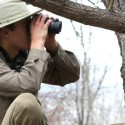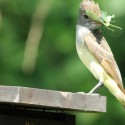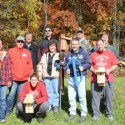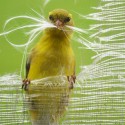 Photo ©
Keith Williams
Photo ©
Keith Williams

Teen’s 5 Tips to Connect Kids With Birds
by Alec Wyatt, teen NestWatcher
As a lifelong naturalist and a birder since grade school, adults often ask me what they can do to get other kids outside and interested in birds. During my time leading younger children in elementary schools, bird walks, and community projects, I have discovered a few ways to bring birding into children’s lives.
1. Engage their senses
The modern devices that pervade our lives—smartphones, tablets, and computers—provide quick access to unlimited information, but they typically stimulate only our visual and auditory senses. Capture kids’ attention by showing them how to appreciate the sight of a bird in nature, the sound of a song or a call, the smell of a natural environment, and the feeling of a banded bird or a feather in the hand.
2. Provide the tools
Let children immerse themselves in discovery by offering them the tools of the trade. Teach young naturalists to use binoculars or a spotting scope. Providing a notebook and a set of pencils allows children to record their own thoughts and observations and preserves their experiences for future appreciation.
3. Bridge the technology gap
Technology does not need to be a barrier between children and nature; rather, it can facilitate a transition from a “plugged-in” lifestyle to a lifetime love of birds. Smartphone applications such as the Merlin app can introduce beginners to bird identification, and soon there will even be a free NestWatch app (coming late 2016).
4. Partner with parents
Children’s community programs, nest box monitoring classes, and introductory birding courses can captivate adults, too. Consider inviting parents and guardians to accompany children on outdoor activities such as bird walks. Collaborating with adults in children’s discovery of birds ensures kids get more support in their endeavors and more time outside watching birds.
5. Give kids responsibility
For older children, having individual responsibility makes the experience of studying birds more personal and engaging. Children can study nest boxes, monitor bird feeders, or count local birds for the Great Backyard Bird Count in February each year. When their contributions to science are encouraged by adults, young birders feel that their interest is valued. When children find value in birds, we gain another generation of advocates for bird conservation.
School will be out soon! Get more resources for engaging young birders from eBird.

We’re Bulking Up
Another 358 nests were bulk-uploaded this month as part of the Forest Preserve District of DuPage County (Illinois) nest box monitoring program. If you’ve got old data to contribute, send it our way. We can upload data sets with 100 or more nest attempts. Learn more about how to bulk upload your data set here.

It Takes a Village
When it comes to involving teens in bird watching, the women behind the Ohio Young Birders Club (OYBC) are leading the way. Darlene Sillick and her colleague Paula Ziebarth, both chapter coordinators in Ohio, are strong advocates for teen NestWatchers.
In addition to teaching the field skills necessary to negotiate a nest box trail (e.g., reading a compass, installing boxes, and checking nests), Darlene and her team also teach math skills. They use the Pythagorean theorem to lay out equally-spaced grids of Tree Swallow nest boxes, to maximize nesting opportunities. The youth also engage in community service, such as helping a researcher rebuild his extensive nest box trail after it was destroyed by a storm. Young birders learn plenty of natural history along the way as they help with Purple Martins, Tree Swallows, Eastern Bluebirds, Tufted Titmice, House Wrens, Prothonotary Warblers, and other species.
Darlene, Paula, and other advisors of the Ohio Young Birders Club don’t just focus on watching birds, they focus on helping birds. In this way, they are able to move teens from a hobby to a passion. Darlene tells us that she “gave her life to bluebirding and conservation.” But we think that she gives much more than her own time…she gives the next generation the hope and practical skills that it takes to face numerous environmental challenges with a can-do attitude. She is mentoring young scientists who will have the enduring optimism which is required of conservation professionals.
It takes a village to raise the next generation of conservationists. We can all provide something—the car, the Saturday afternoon, the tools, the pizza—to help young people on this path.

Top 3 Signs Birds Are Nesting Nearby
Observing birds at the nest is one of the most rewarding aspects of bird watching (along with contributing to science), but there is a skill to finding these hidden treasures. This spring, we’ve gathered our best clues to help you get in on the fun and find nests before the chicks fledge. NestWatch project leader Robyn Bailey shares her top three clues that a bird is nesting nearby.